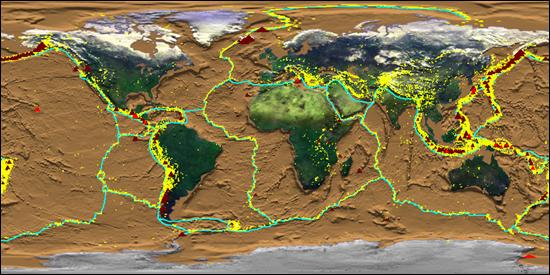Case Study: Predicting the Next Big Earthquake
Recent Earthquake Activity
Earth is a dynamic planet. Its crust is continuously forming and deforming. The crust is constantly pushed and pulled as it moves, causing a strain to build up over time. When this built-up strain is suddenly released, the crust shakes, and we call this movement an earthquake. Depending upon their strength and where they strike, earthquakes can inflict severe property damage and claim thousands of lives.Explore more about recent earthquake activity by clicking the links below. Consider the questions listed below as you investigate earthquake activity at each site.
USGS Recent Worldwide Earthquake Activity
To explore individual earthquakes in more depth, click on the UTC Date-Time field.
- What is the magnitude of the most recent recorded earthquake?
- How many earthquakes were recorded for the last seven days?
- Of those earthquakes, how many were of a magnitude 7.0 or greater?
IRIS Seismic Monitor
Click on the map to zoom to specific regions. Click on individual earthquakes to see lists of others nearby.
- Where are earthquakes concentrated?
Where does Earth Quake?
The geographic distribution of earthquakes on Earth is not random. Due to the stresses and strains associated with a crust that is broken into plates that are moving, earthquakes are predictably concentrated along the plate boundaries and fault systems associated with the plates. Yet, knowing when an earthquake will strike any given place on Earth is not so easy to predict. This map shows earthquakes plotted in yellow against plate boundaries shown in light blue.Image created by NASA/Goddard Space Flight Center - Scientific Visualization Studio.
Predicting the Next Big One!
On a single day on Earth, thousands of earthquakes may occur, but it is the big earthquakes that are usually of interest to people. (An earthquake is considered to be big if it has a magnitude of 7.0 or greater on the Richter scale.) These quakes can cause major damage and loss of life. On average worldwide, about 18 earthquakes per year qualify as big.Seismographs all over the Earth record earthquake activity as it takes place. When predicting where the next big earthquake might occur, seismologists look closely at areas where major earthquakes have occurred in the past, but have not occurred in the last 100 years. However, scientists can not predict the exact location, time, or magnitude of an earthquake. What they can do is identify areas where it is more likely for a big earthquake to occur sooner rather than later. In this chapter, you will examine historical earthquake distributions, monitor current earthquake activity, and try to predict where the next big earthquake will occur on Earth!













